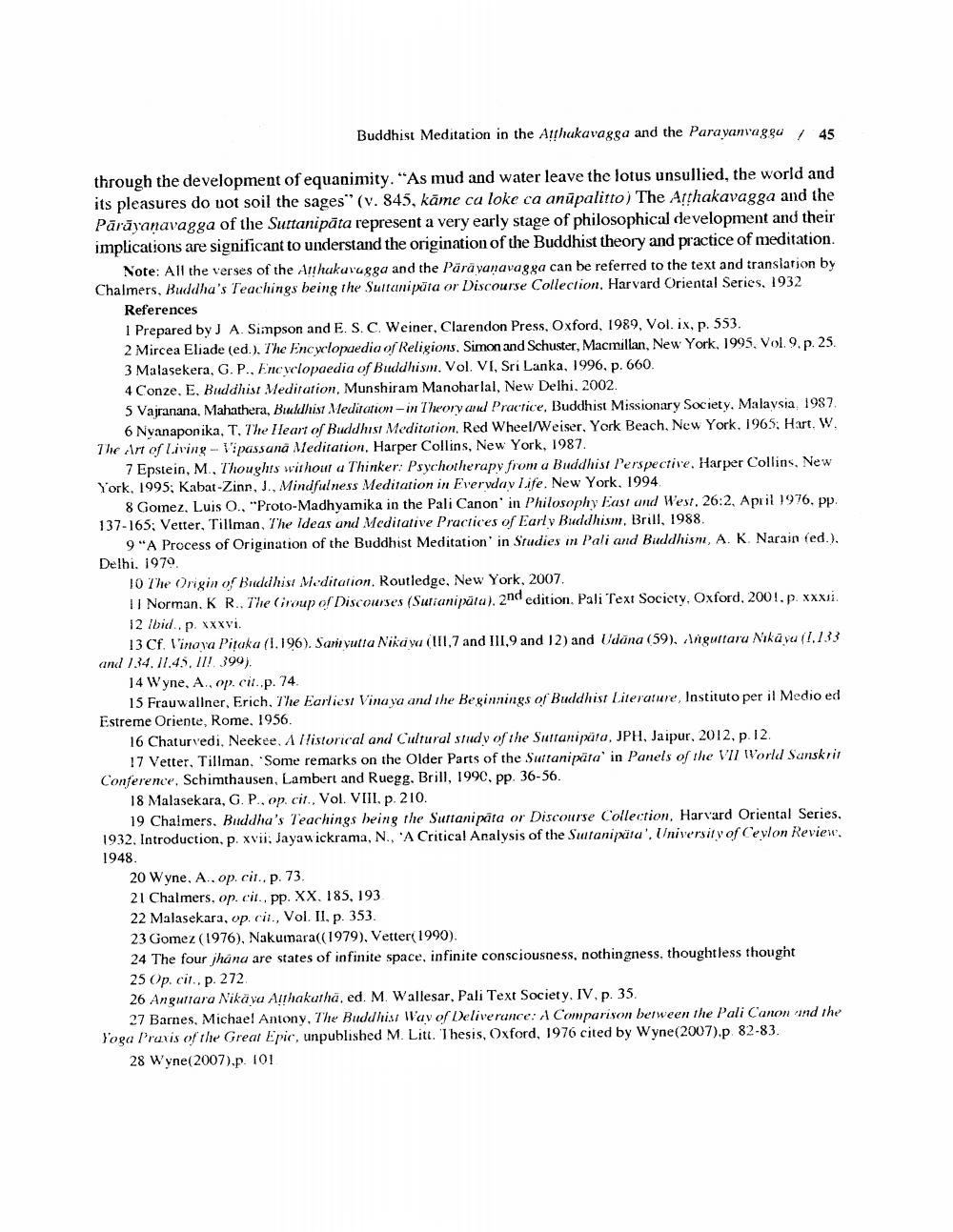________________
Buddhist Meditation in the Atthukavagga and the Parayanvagga 45
through the development of equanimity. "As mud and water leave the lotus unsullied, the world and its pleasures do not soil the sages" (v. 845, kame ca loke ca anupalitto) The Arthakavagga and the Pārāyaṇavagga of the Suttanipata represent a very early stage of philosophical development and their implications are significant to understand the origination of the Buddhist theory and practice of meditation.
Note: All the verses of the Anthakavagga and the Pärāyaṇavagga can be referred to the text and translation by Chalmers, Buddha's Teachings being the Suttanipäta or Discourse Collection, Harvard Oriental Series, 1932 References
1 Prepared by J A. Simpson and E. S. C. Weiner, Clarendon Press, Oxford, 1989, Vol. ix, p. 553.
2 Mircea Eliade (ed.). The Encyclopaedia of Religions. Simon and Schuster, Macmillan, New York, 1995, Vol. 9, p. 25. 3 Malasekera, G. P., Encyclopaedia of Buddhism, Vol. VI, Sri Lanka, 1996, p. 660.
4 Conze, E, Buddhist Meditation, Munshiram Manohar lal, New Delhi. 2002.
5 Vajranana, Mahathera, Buddhist Meditation-in Theory and Practice, Buddhist Missionary Society, Malaysia, 1987. 6 Nyanaponika, T. The Heart of Buddhist Meditation, Red Wheel/Weiser, York Beach, New York, 1965; Hart, W. The Art of Living-Vipassana Meditation, Harper Collins, New York, 1987.
7 Epstein, M., Thoughts without a Thinker: Psychotherapy from a Buddhist Perspective. Harper Collins, New York, 1995; Kabat-Zinn, J., Mindfulness Meditation in Everyday Life. New York, 1994.
8 Gomez, Luis O., "Proto-Madhyamika in the Pali Canon' in Philosophy East and West, 26:2, April 1976, pp. 137-165; Vetter, Tillman, The Ideas and Meditative Practices of Early Buddhism, Brill, 1988.
9 "A Process of Origination of the Buddhist Meditation' in Studies in Pali and Buddhism, A. K. Narain (ed.). Delhi. 1979.
10 The Origin of Buddhist Meditation, Routledge, New York, 2007.
11 Norman. K. R., The Group of Discourses (Sutanipata), 2nd edition. Pali Text Society, Oxford, 2001, p. xxxii. 12 lbid., p. xxxvi.
13 Cf. Vinaya Pitaka (1.196). Samityutta Nikaya (III,7 and III,9 and 12) and Udana (59), Anguttara Nikaya (1.133 and 134. 11.45, II!. 399).
14 Wyne, A., op. cit..p. 74.
15 Frauwallner, Erich, The Earliest Vinaya and the Beginnings of Buddhist Literature, Instituto per il Medio ed Estreme Oriente, Rome, 1956.
16 Chaturvedi, Neekee. A Historical and Cultural study of the Suttanipäta, JPH, Jaipur, 2012, p. 12.
17 Vetter. Tillman, 'Some remarks on the Older Parts of the Suttanipäta' in Panels of the VII World Sanskrit Conference, Schimthausen, Lambert and Ruegg. Brill, 1990, pp. 36-56.
18 Malasekara, G. P., op. cit., Vol. VIII, p. 210.
19 Chalmers. Buddha's Teachings being the Suttanipäta or Discourse Collection, Harvard Oriental Series, 1932. Introduction, p. xvii, Jayawickrama, N., 'A Critical Analysis of the Sutanipäta', University of Ceylon Review, 1948.
20 Wyne, A., op. cit., p. 73.
21 Chalmers, op. cit., pp. XX. 185, 193
22 Malasekara, op. cit., Vol. II, p. 353.
23 Gomez (1976), Nakumara ((1979), Vetter(1990).
24 The four jhana are states of infinite space, infinite consciousness, nothingness, thoughtless thought
25 Op. cit., p. 272.
26 Anguntara Nikaya Anthakatha, ed. M. Wallesar, Pali Text Society, IV, p. 35.
27 Barnes, Michael Antony, The Buddhist Way of Deliverance: A Comparison between the Pali Canon and the Yoga Praxis of the Great Epic, unpublished M. Litt. Thesis, Oxford, 1976 cited by Wyne(2007), p. 82-83.
28 Wyne(2007).p. 101




